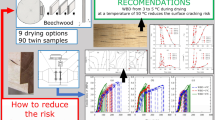Abstract
Moisture-induced stresses resulting from climate variations of the environment can induce cracks in timber members and thus affect the safety and serviceability. The present study highlights—by means of numerical simulations—the distribution and development over time of moisture-induced stresses in various glulam cross sections during wetting. The results show that local stresses may be significantly larger than average stresses, the extent of which strongly depends on the geometrical configuration of the glulam laminates. Suggestions are made on the design of glulam cross sections to minimize the arising local stresses. Furthermore, the studied wetting exposure results in local tensile stresses that exceed the tensile strength of the material. In smaller cross sections, this is the case within few days, while more time is required in wider cross sections.









Similar content being viewed by others
References
Aicher S, Dill-Langer G (1997) Climate induced stresses perpendicular to the grain in glulam. Otto Graf J 8:209–231
Aicher S, Dill-Langer G (2005) Effect of lamination anisotropy and lay-up in glued-laminated timbers. J Struct Eng ASCE 131:1095–1103
Angst V, Malo KA (2010) Moisture induced stresses perpendicular to the grain in glulam: review and evaluation of the relative importance of models and parameters. Holzforschung 64:609–617
Angst V, Malo KA (2012) The effect of climate variations on glulam—an experimental study. Eur J Wood Prod. doi:10.1007/s00107-012-0594-y
Astrup T, Clorius CO, Damkilde L, Hoffmeyer P (2007) Size effect of glulam beams in tension perpendicular to grain. Wood Sci Technol 41:361–372
Blass HJ, Schmid M (2001) Querzugfestigkeit von Vollholz und Brettschichtholz. Holz Roh Werkst 58:456–466
Comsol Multiphysics (2008) User manuals
Frese M, Blass HJ (2007) Failure analysis on timber structures in Germany—a contribution to COST action E55. Paper presented at the first workshop May 2007, Graz University of Technology, Austria
Frühwald E, Serrano E, Toratti T, Emilsson A, Thelandersson S (2007) Design of safe timber structures—How can we learn from structural failures in concrete, steel and timber? Division of Structural Engineering, Lund Institute of Technology, Report TVBK-3053 edn, Lund, Sweden
Gereke T, Niemz P (2010) Moisture-induced stresses in spruce cross-laminates. Eng Struct 32:600–606
Häglund M (2008) Varying moisture content and eigen-stresses in timber elements. Wood Mater Sci Eng 1–2:38–45
Häglund M (2010) Parameter influence on moisture induced eigen-stresses in timber. Eur J Wood Prod 68:397–406
Jönsson J (2004) Internal stresses in the cross-grain direction in glulam induced by climate variations. Holzforschung 58:154–159
Jönsson J, Svensson S (2004) A contact free measurement method to determine internal stress states in glulam. Holzforschung 58:148–153
Jönsson J, Thelandersson S (2003) The effect of moisture gradients on tensile strength perpendicular to grain in glulam. Holz Roh Werkst 61(5):342–348
Mårtensson A, Svensson S (1997) Stress-strain relationship of drying wood—part 1: development of a constitutive model. Holzforschung 51:472–478
Ormarsson S (1999) Numerical analysis of moisture-related distortions in sawn timber. Dissertation, Chalmers University of Technology, Göteborg
Ormarsson S, Dahlblom O, Petersson H (1998) A numerical study of the shape stability of sawn timber subjected to moisture variation—part 1: theory. Wood Sci Technol 32:325–334
prEN 14080 (2011) Timber structures—glued laminated timber and glued solid timber. European committee for standardization, Brussels
Ranta-Maunus A (1993) Rheological behaviour of wood in directions perpendicular to the grain. Mater Struct 26:362–369
Ranta-Maunus A (2003) Effects of climate and climate variations on strength. In: Thelandersson S, Larsen HJ (eds) Timber Engineering. Wiley, Chichester, pp 153–167
Svensson S, Toratti T (2002) Mechanical response of wood perpendicular to grain when subjected to changes of humidity. Wood Sci Technol 36:145–156
Toratti T, Svensson S (2000) Mechano-sorptive experiments perpendicular to grain under tensile and compressive loads. Wood Sci Technol 34:317–326
Virta J, Koponen S, Absetz I (2006) Measurement of swelling stresses in spruce (Picea abies) samples. Build Environ 41:1014–1018
Acknowledgments
The authors acknowledge the support of the work from Norwegian Timber Industry, Norwegian Road Authorities and Christiania Spigerverk AS and Norwegian Research Council under KMB project grant 186821/I10. Specimens are delivered by Moelven Limtre AS and personal communication regarding production issues is highly acknowledged.
Conflict of interest
The authors declare that they have no conflict of interest.
Author information
Authors and Affiliations
Corresponding author
Rights and permissions
About this article
Cite this article
Angst, V., Malo, K.A. Moisture-induced stresses in glulam cross sections during wetting exposures. Wood Sci Technol 47, 227–241 (2013). https://doi.org/10.1007/s00226-012-0493-8
Received:
Published:
Issue Date:
DOI: https://doi.org/10.1007/s00226-012-0493-8




